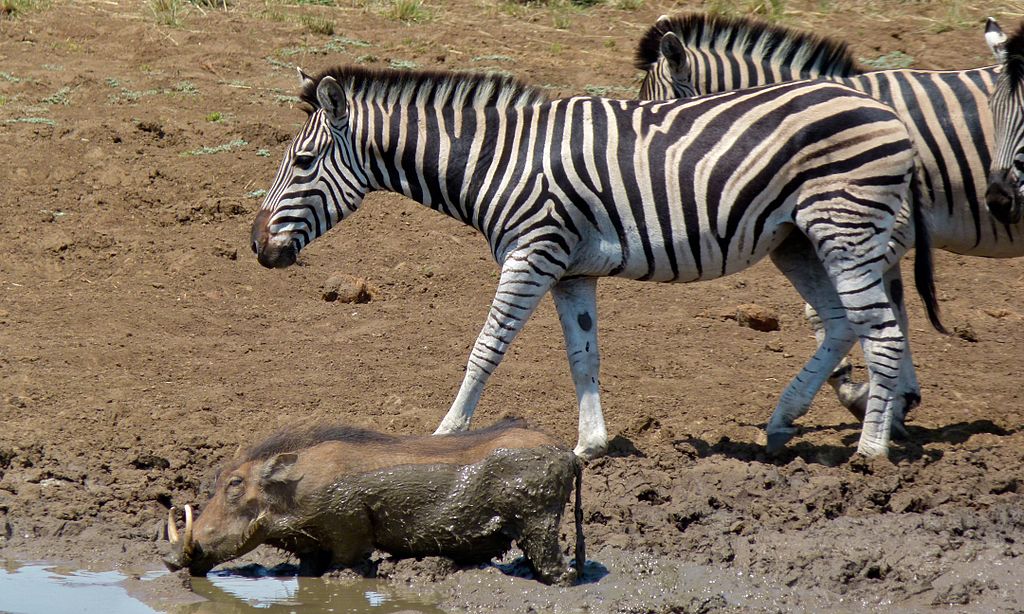Get to know the plucky warthog
NOVEMBER 18, 2019
The warthog won’t win any beauty awards in the bush. But what it lacks in the looks department, it more than makes up for in resourcefulness and spunk. By Nell Hofmeyr
The common warthog is a fitting name for an animal seen around every second bush in Addo Elephant National Park, as well as in Kruger and KwaZulu-Natal. But just because they’re a dime a dozen in the wild doesn’t mean there’s nothing interesting about them. Linger in their presence and you’ll find much to admire about these quirky characters, warts and all.
 Warthogs are a well-known sight in Addo Elephant National Park. Picture by Martinvl.
Looks aren’t everything
Warthogs are a well-known sight in Addo Elephant National Park. Picture by Martinvl.
Looks aren’t everything
Warthogs are universally recognised thanks to Pumbaa. Unlike the Disney character, real hogs are grey-skinned, bristly and a tad less cute.
Look for them in open grasslands and vleis, where they’re easy to spot thanks to their robust build. You’ll know the warthog by its defining feature: a protruding lump or ‘wart’ below each eye. These are technically not warts but protective patches which act as armour during fights. In fact, males have a second pair lower down on the snout for extra cushioning. Their bodies and tusks are also bigger than females, making it easy to differentiate between them.
A dark mane running from the top of head down the middle of the spine completes the animal’s unique look. However, with little fur elsewhere on the body, it’s more mohawk than mane.
 A warthog is easy to ID by its prominent ‘warts’ and tusks. Picture by Ken Nyatta
Follow the tail
A warthog is easy to ID by its prominent ‘warts’ and tusks. Picture by Ken Nyatta
Follow the tail
Warthogs on the move are a sight to behold. Not only do they run surprisingly fast (up to 50km an hour!) but their tails flick bolt upright as they trot. This helps them to follow one another as they move through the veld. Due to their stumpy necks and short legs they wouldn’t otherwise see each other over the long grass. Tall, waving tails are especially useful for piglets but assist warthogs of all ages to keep track of the group.
How low can you go
The warthog’s signature move is to graze on its front wrists, with its snout buried in the ground. It looks almost as if Pumbaa is about to do a somersault. This behaviour, called rooting, leverages the body’s weight to help it dig deeper for food. While their tusks make them look menacing, warthogs are herbivores and eat mostly grass, tubers, seeds, roots, fruit and bark. Rooting is common behaviour when meals on the surface are scarce. In winter, these wild pigs are known to develop heavy calluses on their wrists from all the strain. Ouch!
 To feed, warthogs go down on their front wrists. Picture by Derek Keats
Hidey holes
To feed, warthogs go down on their front wrists. Picture by Derek Keats
Hidey holes
When it comes to finding shelter, warthogs aren’t fussy. They mostly retreat into burrows made by other animals – abandoned aardvark dens are a popular choice. You’ll also spot them in gulleys and caves, or wherever there’s a cosy hole to curl up in. Being popular predator food, they need to keep their wits about them. The female warthog will ensure her little ones are tucked away inside before she backs into the burrow. She enters tail first, ready to fend off unwanted guests with her tusks.
 Did you know? Warthogs are a staple food of lions, leopards and wild dogs, making up almost 15% of their diet.
Girl power
Did you know? Warthogs are a staple food of lions, leopards and wild dogs, making up almost 15% of their diet.
Girl power
In addition to being fiercely protective of their young, female warthogs, or sows, are much more social than males. Female hogs band together in groups called sounders. They assume full responsibility for their offspring whereas adult males lead a solitary life, only joining up with a sounder in mating season. Young males form loose bachelor groups before going their own way upon reaching adulthood.





